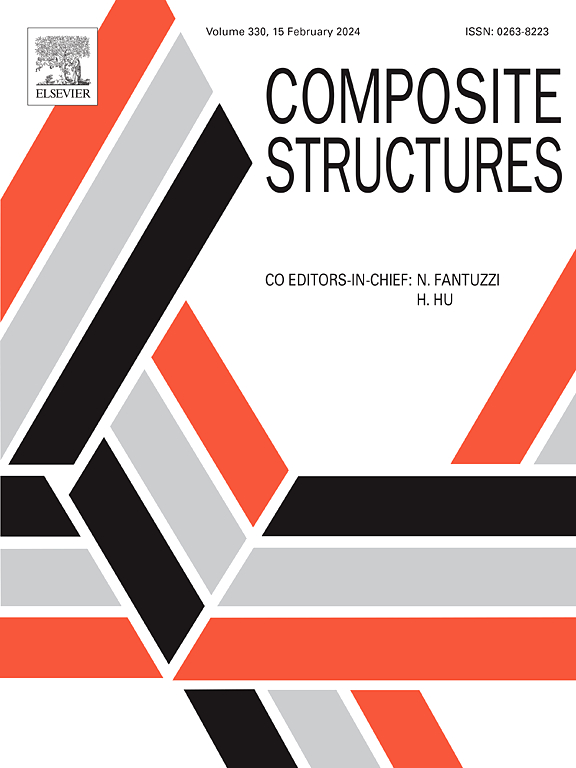基于超声波 Lamb 波的复合材料分层检测非线性指数 RAPID 方法
IF 6.3
2区 材料科学
Q1 MATERIALS SCIENCE, COMPOSITES
引用次数: 0
摘要
准确检测碳纤维增强聚合物 (CFRP) 复合材料中的缺陷(尤其是分层)至关重要,但也极具挑战性。本研究提出了一种无基线λ波损伤成像框架,该框架结合了自适应时间逆转技术和非线性指数重建算法,用于复合材料缺陷的概率检测(NE-RAPID)。该框架结合了两种图像融合策略:全相加和全相乘。NE-RAPID 增强了传统的 RAPID 算法,用衰减更快的指数权重取代了线性权重,从而以更高的分辨率改进了分层和其他缺陷区域的定位。该算法引入了非线性指数加权函数,以解决传感器网络密度不均匀造成的概率分布不均问题,从而提高包括分层在内的缺陷检测的准确性和可靠性。在 CFRP 复合板上进行的实验验证表明,NE-RAPID 明显优于 RAPID。NE-RAPID 在不同频率下的最大检测误差仅为 5.1 毫米,而 RAPID 则高达 34.41 毫米。此外,NE-RAPID 生成的损伤图像更清晰,伪影更少,大大降低了误报风险,提高了整体检测可靠性。这些研究结果表明,NE-RAPID 是一种非常有前途的方法,可用于对复合材料进行精确、可靠的分层检测。本文章由计算机程序翻译,如有差异,请以英文原文为准。
An ultrasonic Lamb wave-based non-linear exponential RAPID method for delamination detection in composites
Accurate detection of defects, particularly delamination, in carbon-fiber reinforced polymer (CFRP) composites is crucial but challenging. This study proposes a baseline-free Lamb wave damage imaging framework that incorporates an adaptive time-reversal technique and a nonlinear exponential reconstruction algorithm for probabilistic inspection of defects (NE-RAPID) in composites. The framework combines two image fusion strategies: full-summation and full-multiplication. NE-RAPID enhances the traditional RAPID algorithm by replacing linear weights with faster-decaying exponential weights, which improves the localization of delamination and other defect regions with higher resolution. A nonlinear exponential weighting function is introduced to address uneven probability distributions caused by the non-uniform density of the sensor network, thereby improving the accuracy and reliability of defect detection, including delamination. Experimental validation on CFRP composite plates demonstrates that NE-RAPID significantly outperforms RAPID. NE-RAPID achieves a maximum detection error of only 5.1 mm across different frequencies, whereas RAPID shows a much higher error of 34.41 mm. Furthermore, NE-RAPID generates sharper damage images with fewer artifacts, significantly reducing the risk of false positives and improving the overall detection reliability. These findings indicate that NE-RAPID is a highly promising method for precise and reliable delamination detection in composite materials.
求助全文
通过发布文献求助,成功后即可免费获取论文全文。
去求助
来源期刊

Composite Structures
工程技术-材料科学:复合
CiteScore
12.00
自引率
12.70%
发文量
1246
审稿时长
78 days
期刊介绍:
The past few decades have seen outstanding advances in the use of composite materials in structural applications. There can be little doubt that, within engineering circles, composites have revolutionised traditional design concepts and made possible an unparalleled range of new and exciting possibilities as viable materials for construction. Composite Structures, an International Journal, disseminates knowledge between users, manufacturers, designers and researchers involved in structures or structural components manufactured using composite materials.
The journal publishes papers which contribute to knowledge in the use of composite materials in engineering structures. Papers deal with design, research and development studies, experimental investigations, theoretical analysis and fabrication techniques relevant to the application of composites in load-bearing components for assemblies, ranging from individual components such as plates and shells to complete composite structures.
 求助内容:
求助内容: 应助结果提醒方式:
应助结果提醒方式:


